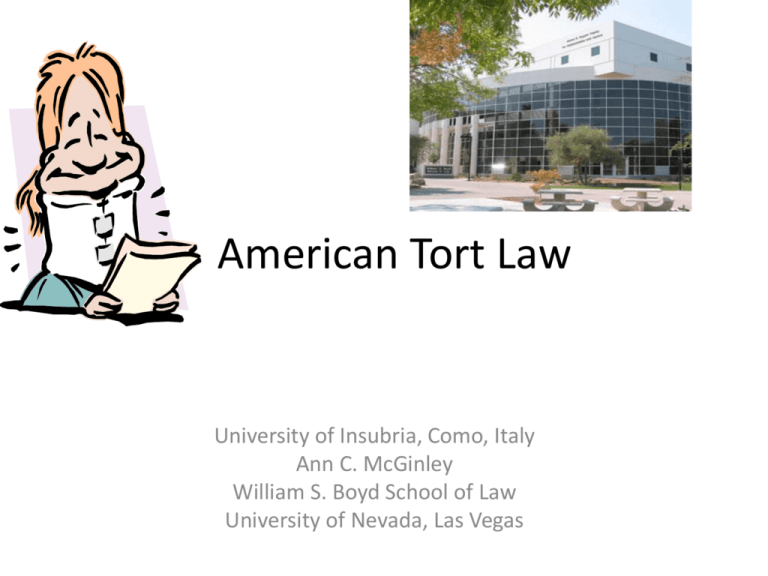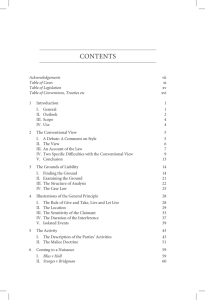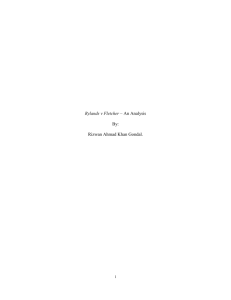American Tort Law
advertisement

American Tort Law University of Insubria, Como, Italy Ann C. McGinley William S. Boyd School of Law University of Nevada, Las Vegas American Tort Law • • • • • State law Common Law system Sometimes codified in statutes Common law vs Code law? The Restatement of Torts Restatement (Second) of Torts • Scholars and lawyers who are members of the American Law Institute compile a statement of what the law is (or should be) • Effort to make common law of different states uniform • Not binding law, but many courts follow them when deciding what the state common law is Example: Public Nuisance – Restatement Second, § 821B • • (1) A public nuisance is an unreasonable interference with a right common to the general public. (2) Circumstances that may sustain a holding that an interference with a public right is unreasonable include the following: • (a) Whether the conduct involves a significant interference with the public health, the public safety, the public peace, the public comfort or the public convenience, or • (b) whether the conduct is proscribed by a statute, ordinance or administrative regulation, or • (c) whether the conduct is of a continuing nature or has produced a permanent or long-lasting effect, and, as the actor knows or has reason to know, has a significant effect upon the public right. [Note: this seems to be a negligence standard] Tort cases in federal court • Some federal laws governing torts • Diversity jurisdiction – citizens are of different states (or of a state and a foreign country) • Federal courts apply the law of the state whose law applies (usually where the injury occurred) • In climate litigation, some argue a federal common law of public nuisance Supreme Court (federal) or (state) • Binding precedent • Stare decisis Lawyers’ Fees in Tort Cases • Contingency Fees What are torts? Types of Torts • • • • • Intentional Negligence Strict Liability Products Liability Personal and Emotional Harms – Defamation – Privacy – Intentional Infliction of Emotional Distress Intentional Torts – Assault – Battery – False Imprisonment – Trespass – Conversion What does “intent” mean? • Acting with purpose to bring about the result • Acting with knowledge that result is a substantial certainty • A high hurdle to prove intent, but at some point we may find an intent in a climate litigation case – For trespass, you only have to intend to enter the land – For conversion, you only have to intend to take the property Trespass • Voluntary entry upon the land of another • Without consent • Could this be used to challenge climate change? (perhaps if your land is harmed by air pollution) • Problem: pollution may not be considered an entry upon the land Trespass Problem • Cat howling on the wall between my neighbor’s and my property. I throw a shoe at the cat and the shoe goes into my neighbor’s yard. Is this a trespass? Image: Francesco Marino/ FreeDigitalPhotos.net Conversion • Treating another’s personal property as one’s own. Converting that property to one’s personal use. eg. – finding a watch and keeping it eg. – borrowing a car and never returning it eg. – stealing a person’s diamond ring • Can conversion be used to challenge climate change? Probably not. Negligence -- Elements • • • • Duty Breach of duty Causation (actual and proximate) Harm What Duty is Owed? • Reasonable care – care that an ordinarily prudent person would take under the circumstances • Would an ordinarily prudent operator of a factory permit emissions to escape if there is another reasonable alternative? • Would an ordinarily prudent person drop a banana peel on the sidewalk? Was it a breach of duty to not have a handrail? To not use scrubbers to reduce emissions? What’s the difference between these cases? Causation • Must Prove: – Actual – Proximate Actual Cause • Actual cause -“but for” cause; doesn’t have to be the only cause; or -Defendant’s act is a substantial factor in bringing about the injury [Can have more than one cause but may be difficult to prove substantial factor if many causes] -Will it be difficult to prove actual cause in climate change litigation? Actual Cause? Proximate Cause Concept of limitation of liability If too remote, courts will not find proximate cause Where do we cut the chain of causation? Difficult to prove in climate change litigation Climate Change Litigation: Proximate Cause? Which defendant is responsible? • Even if you can prove that emissions caused climate change that caused the hurricane, whose emissions? • Very difficult to prove that any one hurricane, etc. is caused by climate change Problems in Negligence • 1. A young law student is walking to school at the University of Nevada, Las Vegas. He crosses the street when the light is green, but a car comes out of nowhere and hits him, breaking his leg and leading to extreme pain. Analyze whether he has a cause of action for negligence against the driver of the car. Problems in Negligence • 2. Same facts as #1 except that the light was red when the student crossed. What result? Problems in Negligence • 3. Change the facts. Assume that the driver of the car had the right of way but that he was speeding. The plaintiff crossed the street when the light was red. What result? Problems in Negligence • 4. Change the Facts. Assume that the driver went through a red light because he was drunk. He was served at a local bar, owned by Joe. Assume that Joe served him 7 drinks and then watched him leave and get into his car. What happens if the student sues the bar for negligence? Problems in Negligence • 5. A lives on a river downstream from B, a battery manufacturing plant. Every day, B discharges toxic chemicals into the river as a result of the plant processes. A and his children get leukemia. Do A and his children have a negligence claim against B? Problems in Private Nuisance • 6. Now A lives in an area in the country where there are no zoning regulations. A meat processing plant moves in next door to A. The plant slaughters pigs to make them into pork. It makes an unbearable smell when the wind blows. A sues the plant for private nuisance. What result? Problems in Private Nuisance • 7. What if A moved to his home after the plant was in operation? Does he still have a suit? Problems in Private Nuisance • 8. What happens if A is there first and a chemical manufacturing plant moves in next door. It spews out dangerous chemicals into the air and makes it intolerable for A to go outside because of the odor? Problem in Trespass • 9. Assume the same facts as in #8. Could the plaintiff also sue for trespass? Strict Liability, Products Liability Strict Liability • • • • • Certain activities – extremely dangerous Eg.- blasting with dynamite, etc. Toxic torts – environmental degradation Nuisance – may attack climate change Common carriers (airplanes, trains) Products Liability • Strict products liability –manufacturer and seller liability for defects in: – Manufacturing – Design – Warning Restatement (Second) of Torts, 1965 Can this theory be applied to automobile design? Design of other machines that produce emissions? Restatement (Second) of Torts, Section 402A • § 402A Special Liability of Seller of Product for Physical Harm to User or Consumer • • (1) Seller of product in a defective condition unreasonably dangerous to the user or consumer liable for physical harm caused to the ultimate user or consumer, or to his property, if • (a) seller is engaged in the business of selling such a product, and • (b) it is expected to and does reach the user or consumer without substantial change in the condition in which it is sold. • • (2) The rule stated in Subsection (1) applies although • (a) the seller has exercised all possible care in the preparation and sale of his product, and • (b) the user or consumer has not bought the product from or entered into any contractual relation with the seller. Restatement (Third) of Products Liability (1998) • § 2 Categories of Product Defect • The product: • (b) is defective in design when the foreseeable risks of harm posed by the product could have been reduced or avoided by the adoption of a reasonable alternative design by the seller or other distributor, or a predecessor in the commercial chain of distribution, and the omission of the alternative design renders the product not reasonably safe; Difference between the Second and the Third Restatements • Second – easier for plaintiff to prove design defect – Test = consumer expectations • Third – more difficult to prove – Test = cost benefit analysis Problems with Product Liability of Car Manufacturer • 1. Is the damage to the air from C02 emissions damage to property? • 2. Causation issues? • 3. Is there a design defect? • 4. Is it a defense if the manufacturer complied with federal regulations by the Dept of Transportation? (DOT) Public Nuisance • Can result from intentional, or negligent conduct or from unreasonably dangerous activity, and therefore create strict liability. • Is ordinarily a common law concept; usually it entails strict liability – Can be state common law or – Federal common law (we will see this later) Public Nuisance – Restatement Second, § 821B • • (1) A public nuisance is an unreasonable interference with a right common to the general public. (2) Circumstances that may sustain a holding that an interference with a public right is unreasonable include the following: • (a) Whether the conduct involves a significant interference with the public health, the public safety, the public peace, the public comfort or the public convenience, or • (b) whether the conduct is proscribed by a statute, ordinance or administrative regulation, or • (c) whether the conduct is of a continuing nature or has produced a permanent or long-lasting effect, and, as the actor knows or has reason to know, has a significant effect upon the public right. [Note: this seems to be a negligence standard] Problem in Public Nuisance • 10. State of California brings a suit against the defendants, a number of manufacturing facilities that spew toxic chemicals and dirt into the air and the water. What does the state have to prove? What are the defenses? Can the state get damages? Or can it only get an injunction? What if the facility is in the public economic interest? Public Nuisance and Climate Change • 11. Assume that there has been a rise in the sea level on beaches off of Alaska. Sea walls have been inadequate and beaches are destroyed. The community wants to sue for public nuisance caused by the destruction of the beaches (caused by climate change). The community has experts who will testify that the emissions from oil and gas plants has caused the climate change. Discuss how the suit should proceed. What problems do you anticipate? Public Trust Doctrine: Source = State statutes or Constitution • Requests the court to declare that: • (1) atmosphere is a public trust asset; • (2) Defendants have a fiduciary obligation as trustees to take affirmative action to preserve the atmosphere and other trust assets from impacts associated with climate change; and • (3) Defendants' fiduciary obligation is defined by what the best available science has determined is necessary to preserve the atmospheric trust. • Butler v. Brewer, (AZ Ct of Appeals, 2013) Case was unsuccessful. Questions • Who would the plaintiffs be in a public trust doctrine case? • In a public nuisance case? • In a private nuisance case? • What are the possible remedies in these cases? Map of the US State of Alaska Map of US and Alaska Kivalina, Alaska People of Kivalina Located on barrier island Kivalina • • • • • • 377 residents 95% native Inupiat City sinking because of global warming Cost to re-locate = $100 - $400 million Poor city – no running water Lawsuit against ExxonMobil, 8 other oil companies, 14 power cos. and 1 coal co. • Seeking damages for global warming that contributed to sinking of island







